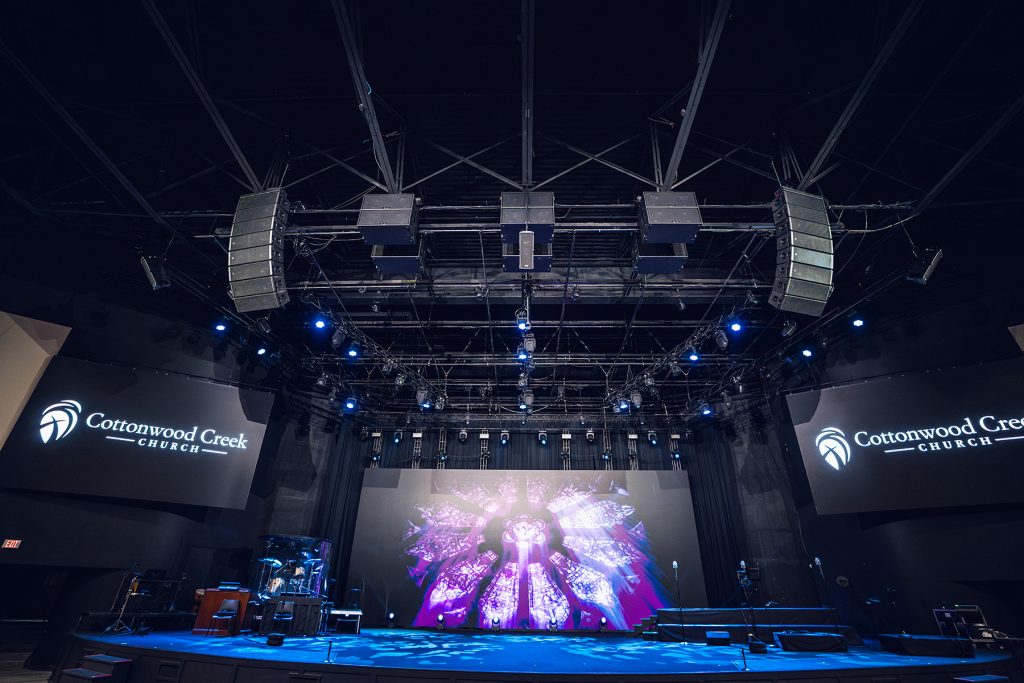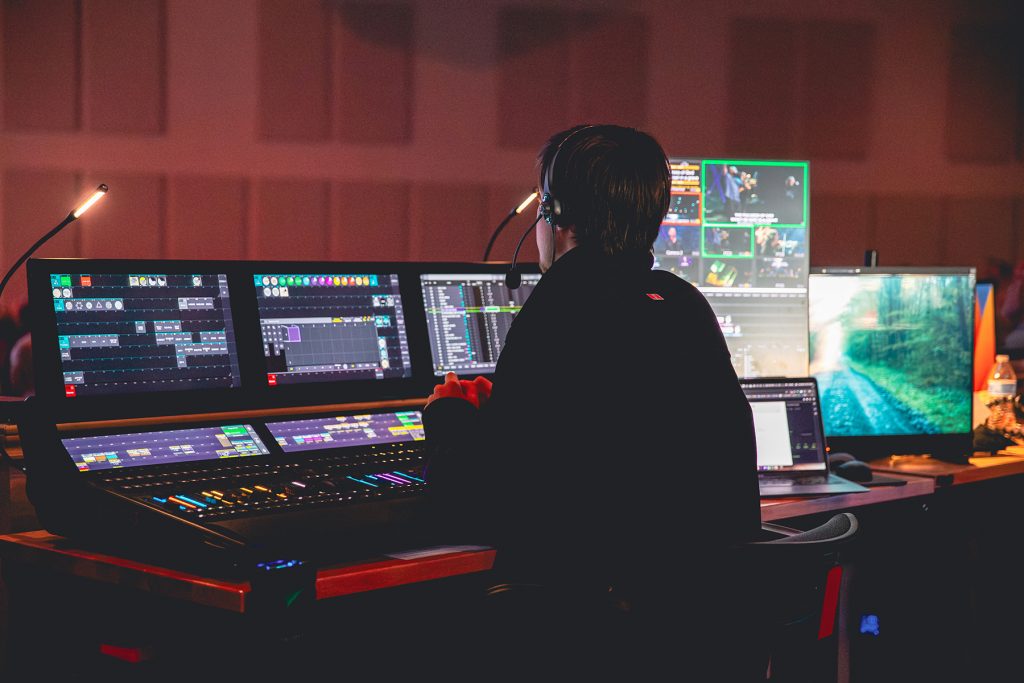
Cottonwood Creek Church, based in Allen, Texas, has recently concluded its “Make Room” campaign which most notably increased the size of its main worship center by 800 seats to near 3000. As a result of the expansion, the existing sound system was inadequate to cover the expanded space. Dallas-based DHSystems, a systems integrator specializing in sound lighting and video equipment with around 75% of its business focused on the house of worship market, implemented a solution based around the first US-installed TT+ Audio GTX line array system delivered by RCF USA.
While Cottonwood Creek did not have a fixed budget, “the cost of the system was a concern,” says Zach Anthony, DHSystems owner, design lead, and senior systems engineer. However, he elaborates, “The cost of expanding the six-year-old speaker system with additional amplifiers and speakers was close to the cost of replacing the whole system with GTX.”
As well as not having the reach to cover the new seating, the existing PA didn’t cover the room evenly. “The design criteria was that every seat have an equal experience,” says Anthony. “Obviously, every seat can’t have an identical experience, but we got very close to that with even coverage front to back and left to right in both frequency response and SPL. We also greatly improved the signal to noise ratio in the room.” Pattern control was an additional issue. “Some of the boxes in the old system were very wide and put a lot of energy on the walls, so there was a lot of reflection. This system has a very precise pattern control for what we need in the room. Intelligibility has gone up.”
Based on their experience and long-term relationship with RCF USA, Inc., DHSystems had no hesitation specifying the TT+ Audio GTX 12 passive three-way line array system before the new components were even shipping. “There’s a left and right array with eight GTX 12 boxes providing primary coverage all the way front to back,” says Anthony. “The center section of the room does not need delay coverage at the back of the room.”
Seven TT 515-A active two-way loudspeakers (compact yet capable of delivering 127 dB SPL) are built into the front of the Cottonwood Creek stage as front fills, while three TTW 4-A active wide directivity two-way loudspeakers (with a 134 dB max SPL spec) are flown with the rest of the PA to provide left/right/center down fill. “If you’re relying solely on front fills,” explains Anthony, “as soon as somebody stands in front of it, the fill is gone. And additionally, if there was only a down fill, the problem then is the imaging is weird if you’re right against the stage – it sounds like the voice of the person speaking right in front of you is coming from overhead. The front fills augment the down fill and they also fix that imaging.” Two additional TTW 4-As are used delayed as fill for the far rear corners of the room.
Twelve of the GTX companion high-performance passive GTS 29 subwoofers, each with dual 19-inch drivers, are flown in three center arc end fire arrays for low frequency extension which “allows us to control the horizontal coverage of the room to where we have equal energy across the width of the room,” says Anthony. “Each sub array has four cabinets, two to the rear, two to the front, we’re able to delay the outer end fire arrays to steer the pattern wider in the room while still having excellent cancellation at the rear.”
The GTX/GTS system is powered and controlled by XPS 16KD Dante®-enabled four-channel DSP amplifiers which, Anthony points out, “has voicings and presets for all of the RCF products – even though the GTX cabinets don’t have amplifiers built into them, it is a complete, closed loop system. For this project, where we have all these speakers in the air, having the amplifiers remotely located in an amp rack is much better from a long-term support and serviceability standpoint.”
RCF’s comprehensive RDNET sound system management and control software were used for the initial system configuration and alignment, including the cabinet voicing and shading. RDNET is currently used for monitoring the system status. “RDNET gives you a nice graphical interface to see everything,” says Anthony. The TT+ Audio system was also interfaced with Cottonwood Creek Church’s existing Q-SYS network, used for facility-wide audio management including reconfiguration for various applications. “The individual speaker voicing is powered by the RCF XPS 16KD amplifiers,” he elaborates, “but the overall system alignment is done through Q-SYS. A Q-SYS Core 610 drives not only the worship center, but all the ancillary spaces – the lobby, the chapel, different breakout rooms and classrooms throughout the entire campus. The signal flow is Dante from the front of house console into Q-SYS, and then Dante back out of Q-SYS into the XPS 16KD amplifiers. We have a hybrid system so there’s analog drive lines. We have the passive GTX 12. We have all the additional self-powered cabinets for fills and delays, and those are fed analog out of the Q-SYS processor.” DHSystems is beta testing a Q-SYS plug-in for the XPS amplifier that lets them monitor the status, the signal level, the temperature and other parameters and control power on and off and all other functions in the Q-SYS environment as well.

FOH at Cottonwood Creek Church’s main worship center. Photo credit: John Hames Photography
The new TT+ Audio system has made “a huge difference both in power, detail and clarity,” Anthony says. John Ellis, A1 FOH mixer at Cottonwood Creek, elaborates: “The system solved so many issues we were faced with. At low volume, the previous system was virtually unintelligible. To get enough presence out of the system, you really had to push it before. Now we can have amazing quality at any volume.” Distortion, he says “even at reasonable volume levels,” was also an issue with the previous system. “While it may not have been noticeable to the audience, the ear fatigue and harshness was there, which lead to a lot more complaints about ‘volume.’” And while SPL levels are closely monitored during Cottonwood Creek services, Anthony recalls that during initial sound checks, they were surprised when they measured a great sounding mix to be over 100 dB SPL, “approaching concert level, but there was no ear fatigue.”
“Another major issue we had,” Ellis continues, “was variance around the worship center. With the FiRPHASE technology that RCF has implemented [an advanced algorithm which corrects phase and amplitude as necessary], and the efficiency of the new boxes, we have incredibly linear and consistent sound throughout the entire worship center – no more hot/dead spots.”
DHSystems’ relationship with RCF USA began about six years ago and has developed to the point that Anthony has helped the company commission systems and with demos at trade shows. “We’ve gotten deeply involved with a bunch of products and helping develop them and improve them,” he says. “I don’t think there’s another single speaker manufacturer that has the width and depth of product line that they do. The retail products are going crazy and it’s definitely a top-selling product line. And now with GTX, they’re playing in the top tier of both the installation and touring applications. They keep hitting home runs.”
Anthony gives service and support from RCF USA high praise. “At some point,” he notes, “something’s going to break or somebody’s going to use it wrong and break it, whether it’s the best product or not doesn’t matter. I work with every manufacturer out there, but I’ve never dealt with a company that understands the urgent needs of production like RCF USA does. They treat people like the working musician who has a product down and needs it for the gig next week with the same urgency as with a major install like this one here at Cottonwood.”
Cottonwood Creek’s facility is frequently used as an event center, rented out for different concerts and events. “We’ve now had three different artists come through and every single one of them left very happy,” says Anthony.
“The system sounds amazing, Ellis enthuses. “Even in an imperfect room, it went from sounding like mixing on a distant PA with the old system, to mixing on studio reference monitors right in front of the console. I have the freedom to mix without being hindered by the system. We needed a system that could provide incredible clarity and fidelity for a wide range of events and services ranging from low to high volume. We needed a system that would still sound present anywhere in the room, without ever sounding distant, and that’s exactly what we got! It has been an incredible blessing to the church.”
Links:
www.rcf.it
www.rcf-usa.com
TT+ Audio:https://www.ttaudio.com/en/
TT+ Audio GTX line array system
TT+ Audio GTX 12 three-way line array module
TT+ Audio GTS 29 high-performance flyable subwoofer
RCF XPS 16KD Dante-equipped 4-channel DSP power amplifier
TT+ Audio TT 515-A professional active speaker
TT+ Audio TTW 4-A wide directivity active speaker
RCF RDNet sound system management and control software
Cottonwood Creek Church




